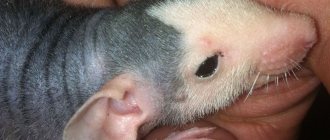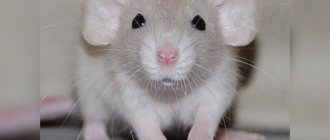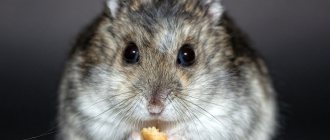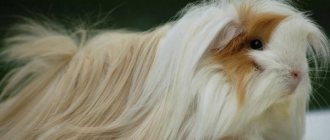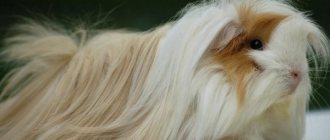Habitat and characteristics of the breed
Rodents of this breed are not found in the wild; they are bred specifically for decorative purposes. The name of the animal was given by a Disney elephant calf, which differs from other representatives of its species by its large ears.
The characteristic features of the Dumbo rat are:
- Large, compared to the size of the rest of the body, low-set, rounded ears
- Pear-shaped short body
- Pointed muzzle
- A long tail
The size of the dumbo rat is practically no different from the size of its relatives; weight – up to 400 grams, length – up to 20 cm. Of course, there are larger individuals, but they are quite rare.
Description of appearance
These animals are unique mainly because of their curly coat. Otherwise they look like other breeds.
It is not difficult to recognize Rex by his appearance. Healthy purebred animal:
- The coat is thick and curly, without bald spots or rosettes;
- The curls on the coat are springy;
- the muzzle is wide and blunt;
- The ears are large and widely spaced;
- fluffy tail.
Character and lifestyle
Since Dumbo is not a separate species of animal, but only one of the rat breeds, the same traits can be traced in their character as in ordinary rodents:
- intelligence
- sociability
- good sense of smell
- friendliness
Dumbo is distinguished from its relatives by its inactivity and low activity. Although there are often exceptions to this rule.
Rodents need communication; they should be given at least 2 hours every day. Otherwise, rats may get bored and stop eating. If the future owner does not have so much time, he can buy a friend for his pet.
Bathing rats
Perhaps, rats can be divided into two “camps” - some are wary of bathing, and you will have serious problems when trying to bathe your pet, while others will happily climb up to perform bathing procedures.
Rats are very clean and you shouldn’t have a need for a “routine” bathing as such, and you shouldn’t bathe rats unnecessarily .
However, there are times when bathing is necessary:
- The rat got very dirty with something that it absolutely cannot eat (while walking around the house, rats can accidentally knock over something).
- The rat emits an unpleasant odor and has an unkempt fur or tail (if you have not had the opportunity to change the cage substrate for a long time, for example, or if the rat does not take care of itself);
- If you need to detect and remove parasites;
- Older rats need to be bathed as they find it difficult to groom themselves.
Care and maintenance
Cell
Domestic Dumbo rats, like other rodents, are kept in a cage. It is best to choose a spacious metal cage
Ideal cell for Dumbo paint
Wooden and plastic rods can be easily chewed or damaged by rodents.
Selection of accessories
In the rodent's home you need to place:
- a house or hammock where the rat will rest and sleep
- various exercise equipment, toys, ladders
- mineral stone for grinding teeth
- special drinking bowl and food bowl
Remember that the cage should not be left in the sun or placed in a draft. The optimal temperature for keeping a pet is 20-22 degrees
Litter selection
Wood shavings or thick paper are ideal as bedding. You should not choose small sawdust: a rodent can accidentally inhale them, which will entail negative consequences and contribute to the manifestation of allergies.
Tip 類: sawdust can be bought in poultry stores or where they sell feed. The price per bag is 200-300₽. When a small bag in a pet store costs 70₽.
Caring for and keeping Dumbo rats involves cleaning the cage as it gets dirty, on average 1-2 times a week. Once a month it must be disinfected.
Varieties
Thanks to breeding work, several varieties of domestic dumbo rats have been developed. They differ in color and coat type.
Dumbo Rex rats have thick, curly fur. The cover is soft and silky. Little rats' fur does not curl, but sticks out in different directions, it looks very funny. In adult pets, formed curls can be seen. Mustaches can also curl.
Siamese
This is a very beautiful and rare variety with an original color, like a Siamese cat. The main shade of six is cream. There is a dark mask on the face and paws.
The gene that is responsible for this type of color is recessive, so it is passed on only to some cubs from the litter. This explains the high cost of Siamese rat pups.
Husky
Dumbo Husky rats are very popular. Pets with this color have dark fur of gray, brown or almost black color. As the animal grows, snow-white hairs appear, which are concentrated in the muzzle area, on the neck and abdomen.
Blue
Decorative blue Dumbo rats are very beautiful, so breeders often sell them at a higher price. These pets have light gray fur with a distinct bluish tint.
Manx
Domestic Dumbo Manx rats are the result of complex genetic mutations. This variety differs from others not in the type of coat or color, but in the absence of a tail.
Although the animal looks funny, life is hard for him without a tail. This part of the body is necessary to maintain balance. It also plays an important role in thermoregulation - the tailless rat often suffers from overheating. Therefore, for reasons of humanity, veterinarians are against breeding Manx cats.
Sphinx
These are unique representatives of the species that differ from their relatives in the absence of hair. The hairless Dumbo rat has numerous folds on its skin, like cats of the same breed. The vibrissae are underdeveloped and curled, but the standard allows for their absence.
Dumbo Sphinx rats require special housing conditions, as they are susceptible to colds and often suffer from skin damage.
Nutrition and prohibited foods
It is important to know exactly what to feed your dumbo rat. Proper nutrition will help keep your pet active and extend its life.
First of all, you need to carefully ensure that the rat always has clean water. The drink should be changed daily.
The diet of a Dumbo rat should be rich in nutrients and vitamins. It is useful to feed them with grain: oats, wheat, barley. To diversify the diet, you can add boiled liver to animal food: kidneys, liver, heart. Rodents should be given nuts to wear down their teeth.
Dumbo loves fresh apples, peaches, ripe bananas, and cherries. But you need to be careful with dried fruits: they contain a high sugar content.
Knowing what dumbo rats eat, you should exclude the following foods from their diet:
- fatty fried foods
- raw potatoes
- radish, turnip, radish
- cabbage
- artichokes
- legumes
- citrus
- mushrooms
- dairy
- sweets
Many people are interested in the question of whether it is possible to feed a dumbo rat with sausage or meat. The answer is clear: you can’t. Sausages contain a large amount of preservatives, spices and salt, which are dangerous for rodents. The same applies to meats that are high in fat.
Small rodents are fed no more than twice a day, adult Dumbo rats more often: three to four.
Filler
In addition to installing a solid layer on the bottom of the cage, you will also need to line it with some kind of substrate. Two popular options are recycled newspaper or aspen shavings. Although you can also use fabric, store-bought litter, or shredded cardboard.
Avoid using cedar or pine litter as they produce toxic fumes that can make your rat sick. You should also avoid cat litter. If your rat accidentally ingests it, it will clump together in the intestines and possibly kill the animal. Corn cob litter has the same problem, but can also become moldy and produce toxic spores.
No matter what type of substrate you use, you will need to clean your rat cage daily. This is to keep them healthy (and to keep your room from smelling like rat droppings).
Diseases and treatment
If the animal is sick, it is quite easy to see. So, a healthy rat is active, has shiny fur and shiny eyes. When an animal feels unwell, the following symptoms appear:
- poor appetite or refusal to eat;
- sluggish appearance;
- strong unpleasant odor of excrement;
- dull coat, etc.
If you notice signs of illness in your pet, contact your veterinarian immediately. Don't forget: some rodent diseases are dangerous to humans.
The most common infectious diseases of rats are:
| Name | Symptoms | Treatment |
| Mycoplasmosis | sneezing; discharge of a specific color from the nose and eyes; labored breathing; lethargy, etc. | Antibiotics, hormones, anti-inflammatory drugs prescribed by a doctor. If left untreated, the disease can be fatal to the rodent. |
| Rabies | lethargy followed by frantic activity; fear of bright light; aggression, etc. | The disease is incurable, the rodent must be euthanized, and the room where it was kept must be disinfected to avoid infecting other animals and people. |
| Pneumonia | sneezing; discharge of a specific color from the nose and eyes; labored breathing; refusal of food; increased drowsiness. | Antibiotics, anti-inflammatory drugs prescribed by a doctor. |
Differences from wild rats
While ornamental rats are very similar to their wild relatives, there are significant differences between them. The most noticeable difference is the appearance. Random mutations (mostly in color) can occur in the wild, but are rare.
Decorative rats are calmer and less aggressive towards humans due to breeding and, as a result, the constant selection of producers with the desired set of behavioral qualities. However, ornamental rats, like any other domestic animals, can become wild and over several generations produced in natural conditions, their behavior and attitude towards humans can become indistinguishable from initially wild rats. This phenomenon is regularly encountered by rat lovers who are engaged in catching colonies or families of decorative rats that find themselves on the street.
Decorative rats have greater body weight and fertility. They are less afraid of new products, they have a calmer reaction to light and sound, and neophobia is less developed. Wild rats are mainly nocturnal, sometimes going out during the day in search of food. In domesticated rats this is not so pronounced. In a fight, wild rats produce sharper screams than domestic ones. In addition, a wild rat that loses a “battle” almost always runs away from the winning one, while domesticated rats can behave differently after a fight.
Domesticated rats live longer than wild ones. This is because kitty rats are protected from predators and always have access to food, water, shelter and veterinary care. Their average lifespan is approximately 2–3 years, unlike wild ones, which on average live less than 1 year. Wild rats have larger brains, hearts, livers, kidneys and adrenal glands. However, decorative rats, like wild ones, are susceptible to many different diseases, among which a special place is occupied by the respiratory syndrome of mouse-like rodents (respiratory diseases of various etiologies), as well as various neoplasms (tumors of the mammary glands, brain, etc.).
Colors
The color of animals of this breed variety, as well as the length and quality of the coat within the species, can vary greatly. Most often there are individuals with short, velvety, straight hair in gray, white, black and chocolate colors. Rare colors of dumbo rats are Siamese, amber, topaz, and mosaic (tricolor).
Amazingly beautiful Dumbo rat of blue mink color. You can find it only from large breeders at a price that is quite high for decorative rats.
Scientists, by crossing rodents of the Dambo breed variety with decorative rats of other breeds, managed to obtain new subspecies that deserve the attention of amateur rat breeders.
Dumbo rats have the following subspecies:
- Dog
- Long-eared cats
- Cat meowing
- Alexandrian parrot
- Why does a cat need a mustache?
- Rescue dogs
- Sphynx - can be white, blue, chocolate and black. Their body is completely devoid of vegetation. There is some hair on the back, paws and head. There are either no mustaches at all, or they are very small and curled upward. Suitable for people with allergies;
- rex - on the contrary, has thick, wavy and fairly stiff hair;
- Husky is a chameleon rat. Only it has the amazing ability to “bloom” - to change color with age. Babies are born of a standard color - black, gray, red, etc., but with age, their fur is diluted with white hairs - so that, born black, a rat pup, having matured, turns into a snow-white miracle. Their ideal color is “salt and pepper.”
Rats are very similar to people - they can dive and swim, are subject to stress and psychological shocks, dream, are afraid of tickling and can laugh, albeit in the ultrasonic range.
Experienced rat breeders know how long domestic Dumbo rats live. And you won’t be able to please beginners with the length of your pet’s life – you need to immediately get used to the idea that your pet will stay with you for about 2-4 years. Thanks to good care and nutrition, many manage to extend their life by a year and a half, but no more.
How to determine gender
The sex of adults can be determined quite easily. To do this, you just need to carefully study the structure of their genitals.
Things are more complicated with baby rats. Their gender can be determined with certainty only a few days after birth.
To determine the gender of a small rodent, you need to pay attention to its tummy, which is still completely devoid of fur. If we can see two rows of nipples, which during this period resemble small pimples, we have a girl; if not, we have a boy.
If you want to keep several rats, but are not going to breed them, choose girls. It will be easier for females to get along together than for males, who will periodically engage in fights for leadership, territory and food.
Breeding
Puberty in Dumbo rats occurs at six months of age. However, there is no need to rush to crossbreed the female. Her body must be fully formed. It is better to wait a month or two, and then place the female with the male in order to obtain offspring.
Pregnancy lasts 21-23 days. There are from 6 to 12 cubs in one litter. Some dumbo rats have regular-sized ears, but when they become adults, they can give birth to long-eared offspring. The animals are born completely bald, blind and deaf. The mother feeds them with milk for 3 weeks.
Dumbo rats grow quickly. After four days, the babies begin to see. The rumor appears approximately on the 12th day after birth. Within 2 weeks, their bodies are covered with soft fur. At this age you can already pick them up. The right time to transfer dumbo rats to new owners is one and a half months.
The gender of a rodent can be easily determined by its nipples. In females they are located along the abdomen in two rows. Males do not have mammary glands.
The Dumbo rat is an ideal pet that does not require a lot of money to maintain. One of his undeniable advantages is his friendly character and strong affection for people. A funny animal can bring a lot of joy to its owner.
Pregnancy and childbirth
A rat's pregnancy lasts just over 20 days; a rounded tummy becomes noticeable by the end of the first week after mating. While bearing offspring, the female needs special attention and careful care. She needs to be provided with adequate nutrition and vitamins.
To give birth in a cage, you should prepare a place where the rodent can retire. If there is no such place, then the expectant mother will make herself a nest from materials found in the home.
The duration of labor is 2-3 hours; one litter can have up to 15 babies.
How to care for newborn rat pups
The female takes care of her offspring herself. The owner can only take care of the mother’s good nutrition and the cleanliness of the cage.
It is strictly forbidden to handle baby rats under two weeks of age. This can anger the female and lead to the death of the offspring.
Choosing a name, examples of names
Every owner wants to choose a bright and original name for their pet. If you follow simple rules, the chosen name for the Dumbo rat will fully meet these requirements:
- it should be easy to understand and short (bad: Archibald, Wilhelmina; good: Archie, Willie);
- It is advisable to use sonorant (r, l, m, n) and hissing (zh, sh, ts, h) consonants in the nickname (bad: Doug, Alice; good: Ricky, Mila).
It is best to purchase a rat from a nursery. This will not only allow you to gain confidence in the authenticity of the chosen breed, but will also significantly expand the number of possible options for the color and texture of the coat. In addition to the usual rodent of this breed, you can buy there:
- Siamese
- rex
- blue
- husky
- white
